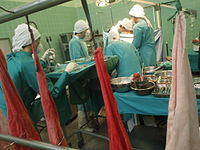
Photo from wikipedia
Transplantation of liver grafts from donation after cardiac death (DCD) is limited. To identify barriers of DCD liver utilization, all active US liver transplant centers (n = 138) were surveyed, and the… Click to show full abstract
Transplantation of liver grafts from donation after cardiac death (DCD) is limited. To identify barriers of DCD liver utilization, all active US liver transplant centers (n = 138) were surveyed, and the responses were compared with the United Network for Organ Sharing (UNOS) data. In total, 74 (54%) centers responded, and diversity in attitudes was observed, with many not using organ and/or recipient prognostic variables defined in prior studies and UNOS data analysis. Most centers (74%) believed lack of a system allowing a timely retransplant is a barrier to utilization. UNOS data demonstrated worse 1‐ and 5‐year patient survival (PS) and graft survival (GS) in DCD (PS, 86% and 64%; GS, 82% and 59%, respectively) versus donation after brain death (DBD) recipients (PS, 90% and 71%; GS, 88% and 69%, respectively). Donor alanine aminotransferase (ALT), recipient Model for End‐Stage Liver Disease (MELD), and cold ischemia time (CIT) significantly impacted DCD outcomes to a greater extent than DBD outcomes. At 3 years, relisting and retransplant rates were 7.9% and 4.6% higher in DCD recipients. To optimize outcome, our data support the use of DCD liver grafts with CIT <6‐8 hours in patients with MELD ≤ 20. In conclusion, standardization of donor and recipient criteria, defining the impact of ischemic cholangiopathy, addressing donor hospital policies, and developing a strategy for timely retransplant may help to expand the use of these organs. Liver Transplantation 23 1372–1383 2017 AASLD.
Journal Title: Liver Transplantation
Year Published: 2017
Link to full text (if available)
Share on Social Media: Sign Up to like & get
recommendations!